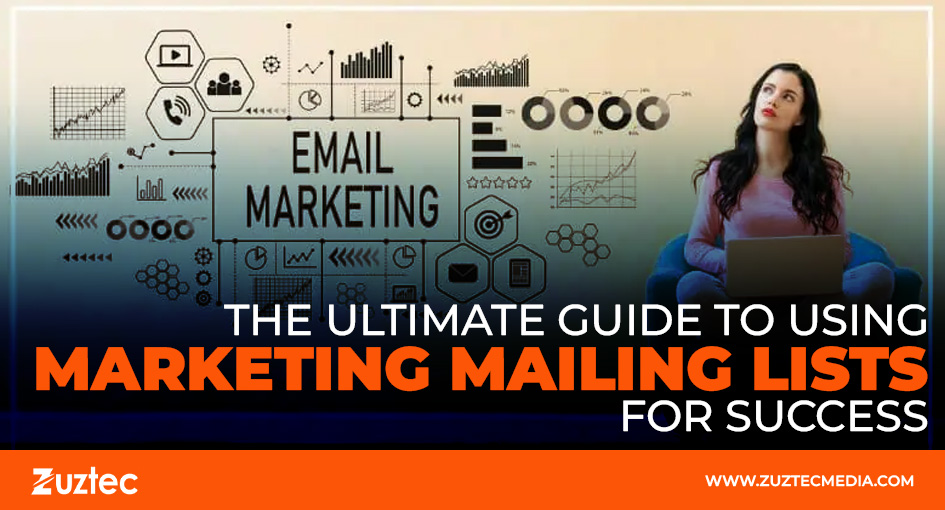
The Ultimate Guide to Using Marketing Mailing Lists for Success
In the digital age, email marketing continues to be one of the most powerful and cost-effective tools for businesses to connect with their customers. It allows companies to reach a wide audience directly and personally, fostering deeper relationships with current and potential customers. However, the key to a successful email marketing campaign goes far beyond just crafting compelling content; it lies in targeting the right audience with precision. This is where marketing mailing lists come into play. A well-curated mailing list ensures that your messages land in the inboxes of the individuals most likely to engage with your content, increasing your chances of conversions and driving sales.
Building and maintaining a quality marketing mailing list can significantly enhance your business’s ability to reach and nurture its target audience. But how do you ensure you’re using it effectively? From collecting the right contacts through opt-ins to segmenting your lists for personalized messaging, each step in the process plays a vital role in driving results. Additionally, continuously cleaning and maintaining the list will help to optimize deliverability and engagement rates. In this guide, we’ll explore how to harness the full potential of marketing mailing lists, why they are essential for your email marketing strategy, and provide practical tips on building, segmenting, and maintaining them to maximize their impact on your business.
Why Marketing Mailing Lists Matter
Marketing mailing lists are fundamental to the success of any email marketing campaign. Without a relevant and high-quality list, even the best-crafted emails will not have the desired impact. Mailing lists give businesses a direct line to customers and potential customers, which is invaluable in today’s competitive digital landscape. In contrast to paid advertisements or social media, which rely on budgets and algorithms to reach the correct audience, an email list enables you to speak with people who have expressed interest in your company, goods, or services directly.
Not only does this increase the chances of customer engagement, but it also boosts the return on investment (ROI) for your campaigns. In fact, studies show that email marketing has an average ROI of $42 for every dollar spent. This is because emails are highly personalized, deliverable directly to the inbox, and often lead to higher engagement rates.
Segmenting Your Marketing Mailing List
Once you’ve started building your mailing list, it’s time to segment it. List segmentation is the practice of dividing your list into smaller, more specific groups based on factors like demographics, purchase history, and engagement levels. Proper segmentation ensures that you’re sending the right message to the right people, which significantly improves your chances of engagement and conversions.
Here are a few strategies for list segmentation:
- Demographic Segmentation
Sort your list according to demographic criteria like region, income level, gender, and age. This allows you to tailor your messages to the specific needs and preferences of each group.
- Behavioral Segmentation
Use data on your customers’ behavior, such as their browsing or purchase history, to group them into segments. This enables you to send highly relevant content, such as product recommendations or abandoned cart reminders.
- Engagement-Based Segmentation
Categorize subscribers based on how frequently they engage with your emails. For example, you can separate highly engaged subscribers from those who rarely open your emails and tailor your content accordingly. You can also send re-engagement campaigns to inactive subscribers to reignite their interest.
Crafting Compelling Email Campaigns
A marketing mailing list is only effective if it’s paired with well-designed and valuable email campaigns. Here are some tips for creating emails that capture attention and drive action:
- Personalize Your Emails
Personalization is one of the best email marketing techniques. Addressing subscribers by name, recommending products based on previous purchases, or sending tailored content based on their interests will make them feel valued and encourage higher engagement.
- Focus on Compelling Subject Lines
The subject line is the first thing subscribers see, and it plays a huge role in whether they open your email. Make it short, relevant, and intriguing. Use action verbs and create a sense of urgency or exclusivity to encourage opens.
- Include Clear Calls to Action (CTA)
Every email should have a clear and concise call to action that tells the reader what to do next—whether it’s making a purchase, reading a blog post, or downloading a resource. Ensure your CTA is easy to spot and motivates the reader to take action.
Maintaining and Cleaning Your Marketing Mailing Lists
A crucial aspect of marketing mailing lists is ensuring that they remain up-to-date and clean. Over time, your list will accumulate inactive, outdated, or invalid email addresses. Failing to clean your list can lead to low engagement rates, higher bounce rates, and potentially damage your sender reputation.
Here’s how to maintain a healthy list:
- Regularly Remove Inactive Subscribers
Identify subscribers who haven’t opened your emails in a while and consider removing them from your list or sending a re-engagement campaign to win them back.
- Use List Hygiene Tools
Use email validation tools to ensure that the email addresses in your list are valid and active. This helps reduce bounce rates and maintain deliverability.
- Ask Subscribers to Update Their Preferences
Allow subscribers to manage their preferences, such as updating their email frequency or interests. This ensures that they receive relevant content without feeling overwhelmed.
In conclusion, marketing mailing lists are a powerful tool that, when used effectively, can significantly improve your email marketing strategy. By building a high-quality, permission-based list, segmenting it appropriately, crafting personalized campaigns, and maintaining list hygiene, you can maximize your ROI and achieve long-term success. In today’s highly competitive digital world, a well-targeted and engaged mailing list is one of the most valuable assets your business can have. Start implementing these strategies today to set your email marketing campaigns up for success.

